Concentrations of holiday homes 2020
Stockholm county has the most holiday home areas
Statistical news from Statistics Sweden 2022-11-24 8.00
There are more than 610,000 holiday homes in Sweden. Almost a quarter of them are located so densely together that they can be grouped into holiday home areas. This gives a total of more than 1,150 holiday home areas in the whole of Sweden. The areas are often located along the coast, next to large lakes and in mountainous regions. Stockholm county has the most holiday home areas.
The holiday home areas take up 0.15 percent of Sweden’s total land area. The largest surface area of holiday home areas is in Stockholm county, where they make up nearly 3 percent of the county’s land area. It also has the highest number of holiday home areas – numbering 274. After that comes Västra Götaland county with 185 areas, and Skåne county with 83 areas. The southern mountainous counties, Dalarna and Jämtland, also have many holiday home areas.
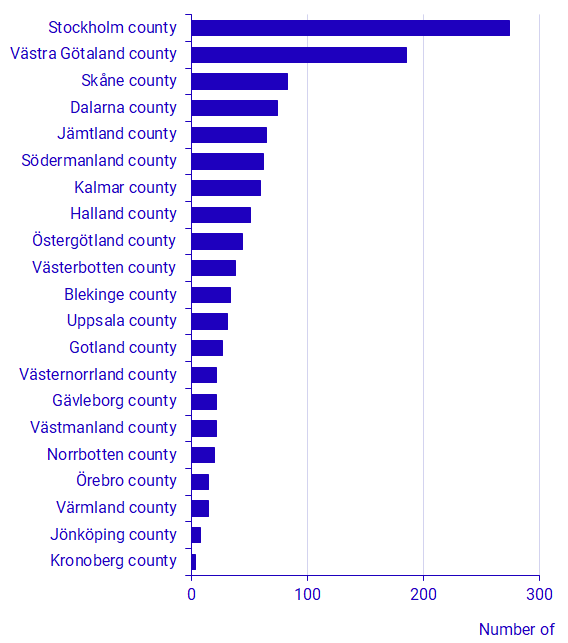
When Sweden’s holiday home areas are shown as dots on a map, strings of areas appear along the coasts. There are also concentrations of areas in Mälardalen, around Lake Siljan and in the mountainous regions of Sweden.
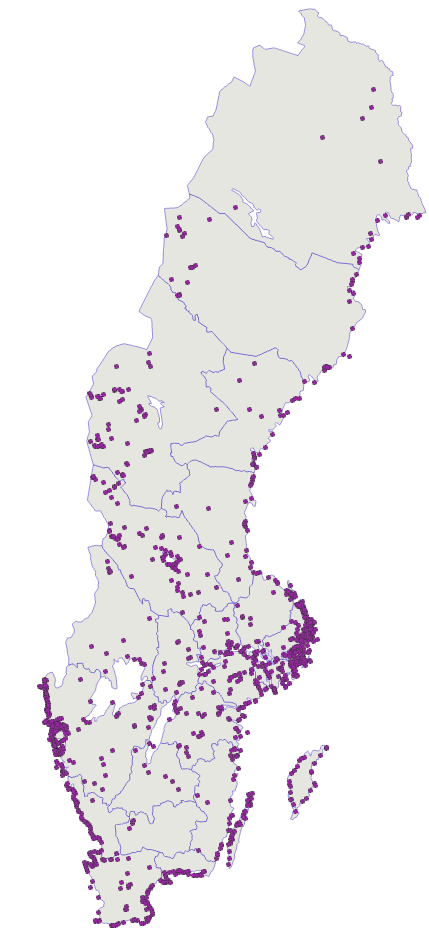
Source: Statistics Sweden
Each purple dot shows a holiday home area. The points are greatly enlarged in relation to their actual size on the scale of the map.
A quarter of holiday homes are located in holiday home areas
A holiday home area consists of at least 50 densely located holiday homes. Far from all holiday homes can be grouped into holiday home areas. Out of Sweden’s 610,000 or so holiday homes, 143,000 – or 24 percent – are located in holiday home areas. The number of holiday homes that can be grouped into contiguous areas varies from one part of Sweden to another. In Halland county, 60 percent of all holiday homes are located in a holiday home area and in Stockholm county, the proportion is 45 percent. Kronoberg county has the lowest proportion of holiday homes forming holiday home areas, at 2 percent. It is also the county with the lowest number of holiday home areas, with four areas.
Vellinge, in the south-western corner of Skåne county, has the highest proportion out of the municipalities. There, nearly 80 percent of holiday homes are located in a holiday home area. Two municipalities in Halland county come next – Falkenberg (76 percent) and Halmstad (72 percent). We find the lowest proportions of holiday homes in holiday home areas in the inner parts of Sweden, from north to south, and in the northernmost regions of the mountain range. 106 of Sweden’s 290 municipalities have no holiday home areas at all, although all municipalities have holiday homes.
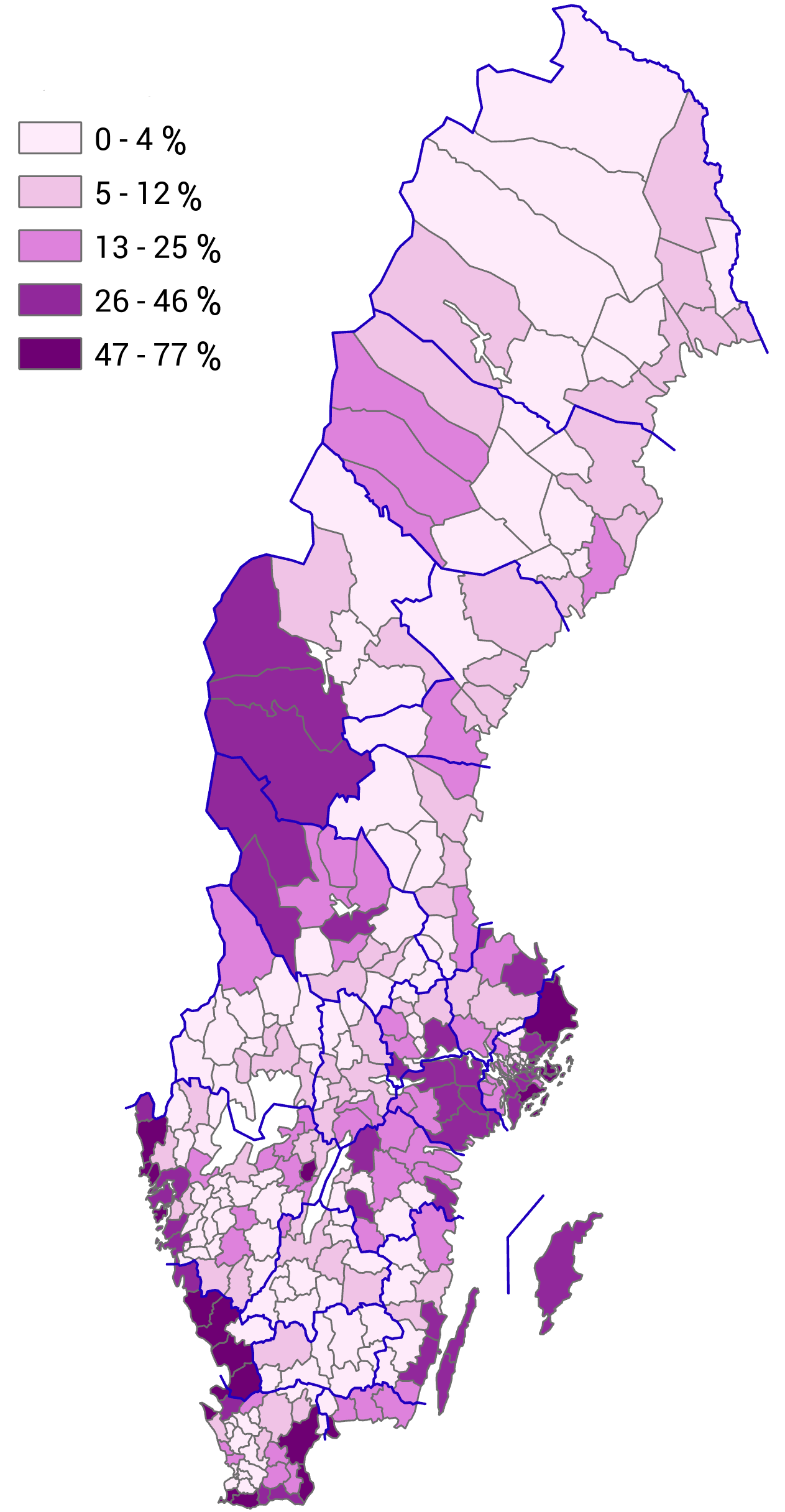
Source: Statistics Sweden
Holiday home areas in unexpected places
The term “holiday home area” might evoke a relatively homogeneous settlement in terms of construction year, standard and architecture. There might be simple cottages built with the intention to be used as leisure-time accommodation only, usually during the summer months. There might also be better insulated houses in the mountainous and northern parts of Sweden, perhaps at ski resorts.
According to Statistics Sweden’s definition, a holiday home is a single-dwelling house with no registered residents according to the population register. This means that houses other than those built as holiday homes can be counted as holiday homes in the statistics. Examples of this are older permanent dwellings that have been converted into holiday homes, by the fact that nobody resides at the property according to the population register. It can also be a case of new houses built to a very high standard, the owner of which has chosen a different registered address for various reasons. Trends in this respect are visible in the statistics, in that holiday home areas are formed in places that are not normally associated with, or originally intended to be, holiday home areas. There are, for example, several holiday home areas in central parts of coastal towns, such as Visby, Ystad and Båstad.
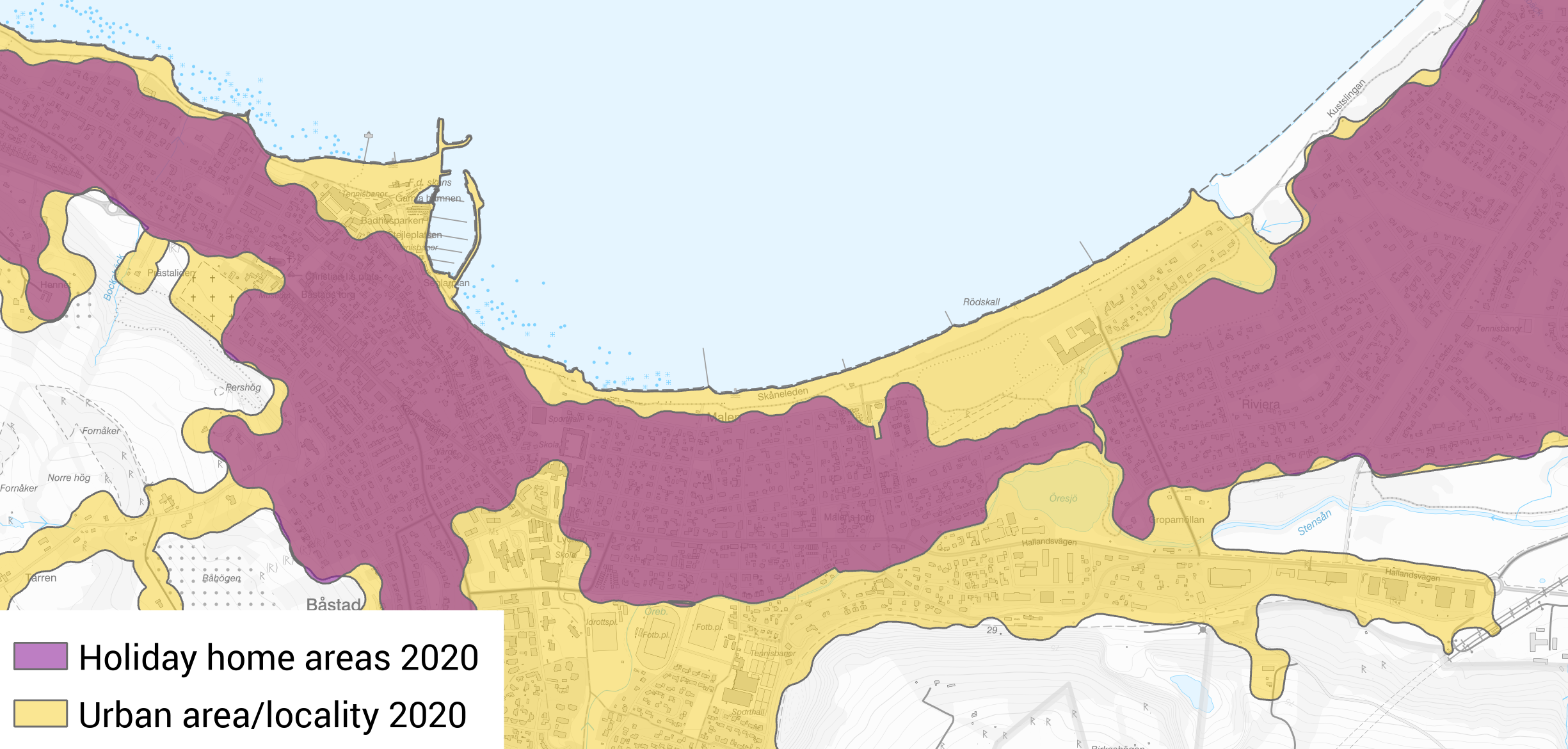
Source for boundary holiday home area and urban area/locality: Statistics Sweden. Background map: ©Lantmäteriet.
The opposite also occurs when previously distinct holiday home areas are converted into areas with numerous permanent dwellings. This is a development that is often seen in commuting distances from larger localities, where there is a great need for new homes. This leads to a heightened conversion of holiday home areas into localities, or a greater overlap between localities and holiday home areas. These areas also have a high proportion of single-dwelling houses that are not holiday homes because the permanent population is large. This type of progression is visible in for instance former pure holiday home areas such as Årsta Havsbad in Stockholm county and Mellbystrand in Halland county.
Holiday home areas and localities on the same land area
Half of the total surface area of holiday home areas is overlapped by localities. In turn, 4 percent of the localities are overlapped by holiday home areas. However, there are substantial regional and local differences. Gotland county has the highest proportion of locality area that is overlapped by holiday home areas. There, 18 percent of the locality area is also holiday home areas. In Halland county, that figure is 13 percent.
Out of the municipalities, Sotenäs, on the west coast of Sweden, has the highest proportion of locality area that is overlapped by holiday home areas. There, half of the locality area is also holiday home areas. This is followed by Båstad and Borgholm, where 39 percent of the locality area is overlapped by holiday home areas. However, in the vast majority of municipalities the proportion is very low. In nearly 80 percent of municipalities, the proportion is lower than 5 percent.
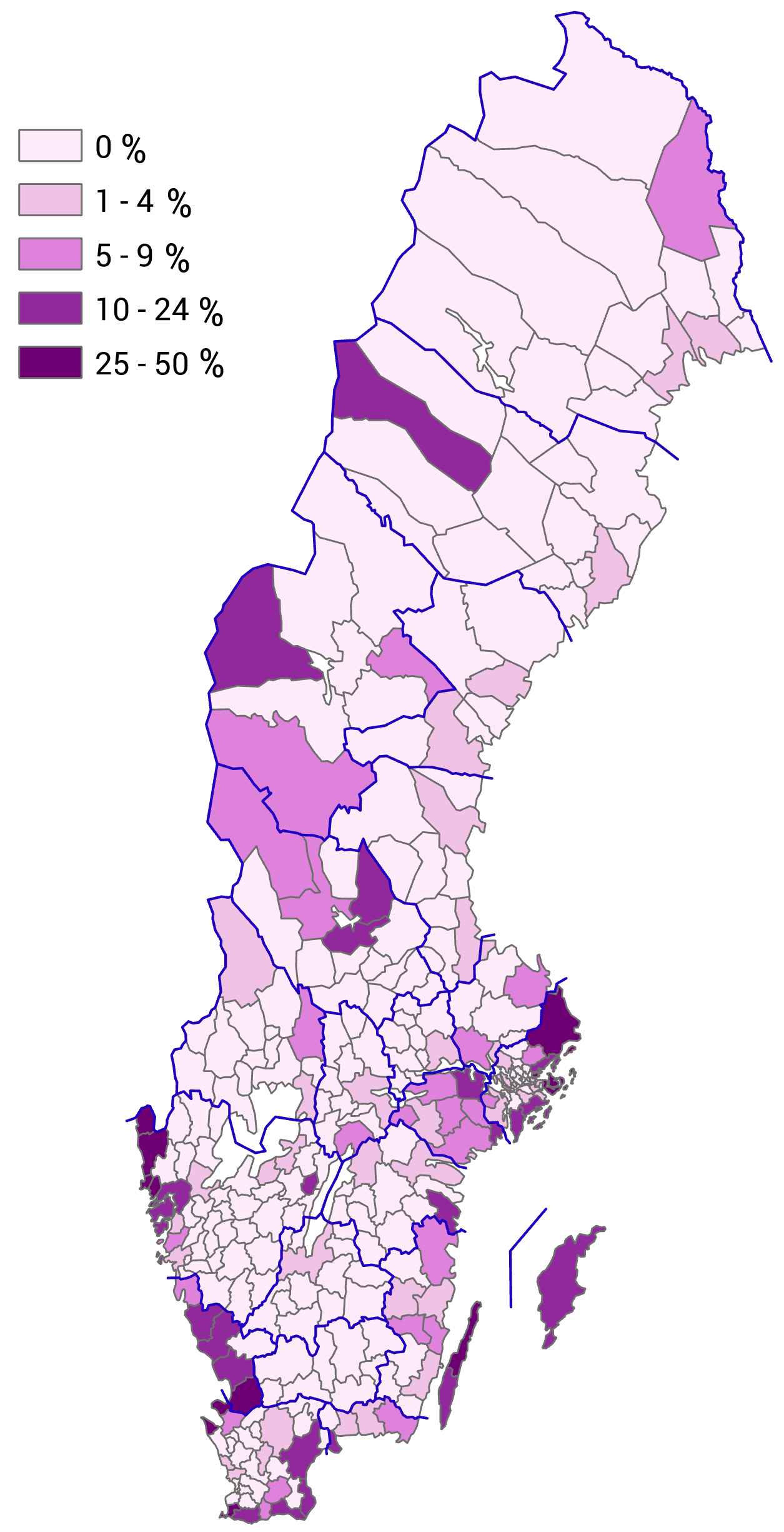
Source: Statistics Sweden
62 percent of holiday homes are in holiday home areas
Statistics Sweden’s holiday home areas can contain both holiday homes and permanent dwellings. On average, holiday homes make up 62 percent of the areas’ total number of buildings (excluding supplementary buildings). Jämtland county has the highest proportion – 79 percent - of holiday homes in holiday home areas. Skåne county has the lowest proportion – 43 percent.
The proportion of holiday homes out of the total number of one- or two dwelling buildings in holiday home areas provides a picture of how much of the area is primarily used for leisure. On average, two-thirds of the areas’ one- or two dwelling buildings are not permanently occupied; that is, they are classified as holiday homes. The highest proportion is in Jämtland county, where holiday homes make up 82 percent of all one- or two dwelling buildings, in holiday home areas. Skåne county has the lowest proportion, where holiday homes make up less than half of all the areas’ one- or two dwelling buildings, in holiday home areas.
Out of the municipalities, the proportion varies between 15 percent in the municipality of Helsingborg and 98 percent in the municipalities of Vadstena and Säffle. The lower proportions are mainly located in Skåne. The higher proportions are more dispersed across the country, without any clearly discernible patterns. The municipalities that do not have any holiday homes at all are not included in the calculation and are shown in grey in the map below.
Proportion of holiday homes out of the total number of one- or two dwelling buildings in holiday home areas, by municipality, 2020
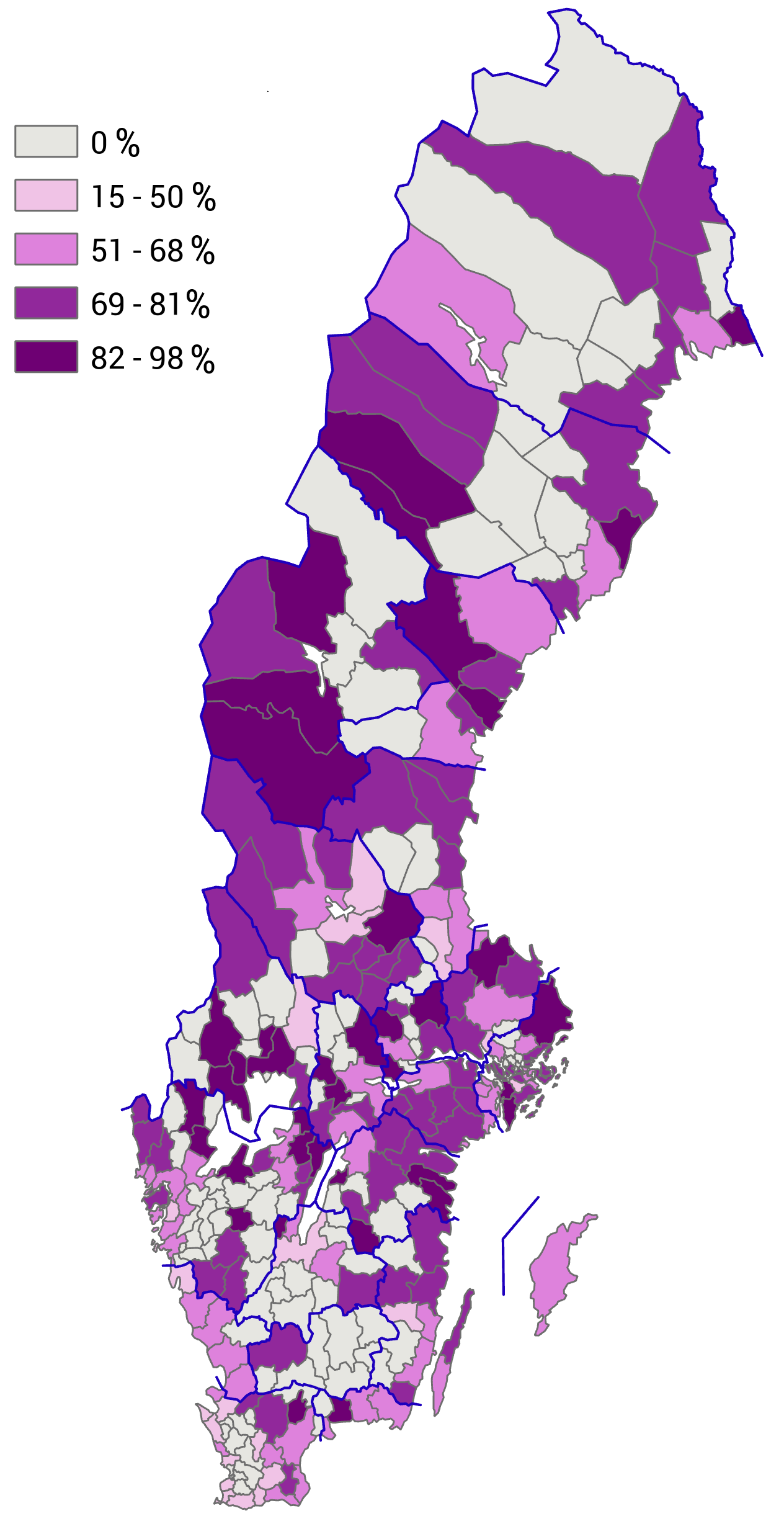
Source: Statistics Sweden
Definitions and explanations
A holiday home is a one- or two dwelling building (detached house, terraced house, row house, etc.) without anybody registered at the property according to the population register, which is owned by natural persons or estates.
A holiday home area consists of at least 50 holiday homes, where the maximum distance between the holiday homes is 150 metres.
An urban area/locality is a densely built-up area with at least 200 registered inhabitants.
The statistics concern the situation as of 31 December 2020 and 1 January 2021.
Feel free to use the facts from this statistical news but remember to state Source: Statistics Sweden.
